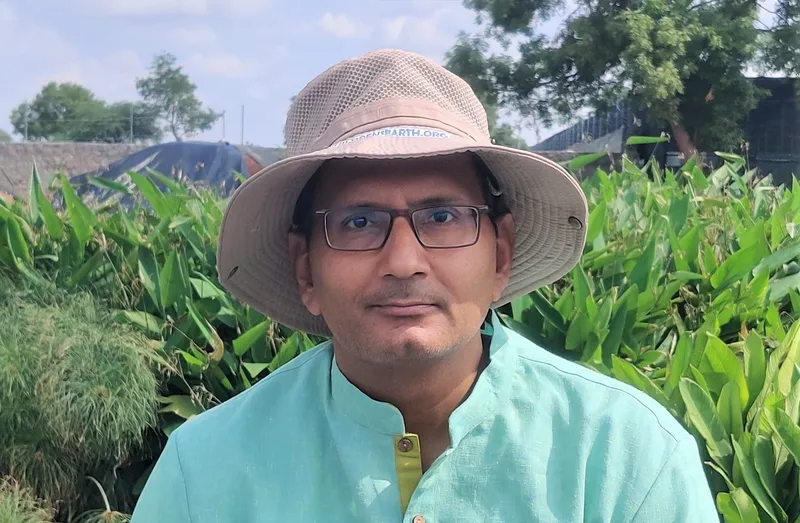This NGO is championing water conservation through greywater recycling
After quitting his job in London, Prashant Sharma started a non-profit organisation in—‘Positive Action for Child and Earth Foundation’, in 2021. The NGO primarily recycles greywater in schools, colleges and other organisations.
A common sight in Bengaluru and several cities is people standing in queues, hoping to get at least a bucket of water. This year's relentless summer has only added to the already dire water crisis.
According to the Ministry of Water Resources, India's average annual water availability per capita is projected to drop from 1,486 cubic metres in 2021 to 1,367 cubic metres by 2031. A level below 1,700 cubic metres indicates water stress, with 1,000 being the threshold for water scarcity.
This situation calls for urgent action.
Among many others working towards water recycling, Prashant Sharma believes it is the need of the hour.
After quitting his job in London, he started a non-profit organisation —‘Positive Action for Child and Earth Foundation’, in 2021. The Delhi-based NGO primarily recycles greywater in schools, colleges and other organisations.
Greywater is wastewater from non-toilet plumbing systems such as hand basins, washing machines, showers, and baths. According to a report by Down to Earth, an estimated 31 billion liters of greywater is generated daily in India. In contrast, blackwater is the wastewater from bathrooms and toilets that contains fecal matter and urine. The Central Pollution Control Board has estimated that the country generates 72,368 million liters per day (MLD) of sewage (blackwater) annually.
"The problem is that in most places, greywater and blackwater are mixed together and sent to sewage treatment plants, or sometimes discharged untreated. Greywater is least contaminated and can be treated economically in a decentralised manner. Additionally, if greywater is treated separately, it would massively reduce the carbon footprint of STP’s, as they consume a lot of energy," Sharma tells SocialStory.
A calling

Prashant Sharma
Sharma, born in Mumbai, witnessed the lack of water firsthand. Growing up, he recalls that in his household, each person was allowed only one bucket of water per day.
This personal experience made him aware of the water scarcity issues. As he grew up, he read news and reports of water shortages in various parts of the World which further deepened his concerns.
He always wanted to work towards water conservation, but didn’t know how.
The turning point arrived in 2005 when he was working in London. Sharma saw many people in his borough spoke about environmental issues and take active steps like conducting awareness and waste segregation campaigns, recycling initiatives, among other things. He was also a designated recycling champion for his borough.
"I have been passionate about water conservation. During my time in the UK,I realised that as a developing nation, India should also start adopting active recycling measures,” he adds.
This idea motivated him to return to India in 2015. While continuing his job as an engineer, Sharma set his foot in the social impact space.
He started conducting awareness sessions on afforestation and water conservation in schools and colonies.
He quit his job in 2017 to focus on environmental work. In 2021, he decided to give more structure to the work he was doing. This led him to start the NGO.
Recycling greywater
Sharma explains that the NGO recycles greywater via constructed wetlands.
Constructed Wetlands (CW) are built using natural filter materials like clay, moringa cake, activated charcoal, wood shavings, grit, graded stones and sand.
He explains that the wetlands are carefully designed so that water is retained in them for a specific time The heavy solids, organic matter and nutrients settle down. These are then naturally broken down and absorbed by bacteria and roots of aquatic plants, cleaning the greywater in the process.
After treatment the water can be reused for non-potable activities such as watering plants, landscaping, and toilet flushing, among other uses.
Before starting any project in a school or building, the NGO conducts an audit to assess the amount of greywater being generated. They then test the water for bacteria and fecal matter. If fecal matter is detected, they try to identify the point of leakage where it is mixing with the greywater and repair the point.
He says that they use dual piping, among other ways, to divert the greywater before it mixes with the blackwater.
The third step is to design a solution catering to specific needs. This can vary depending on factors such as the volume of water, level of contamination, intended use and others.
He suggests that for high-rise buildings, the compact and highly efficient modular resin-based ultra-filtration systems work best. In this system, the grey water is treated and reused multiple times in a closed circular loop till the water gets contaminated enough to be discharged as blackwater in the end. A more advanced version of the ultrafiltration modular system can also treat the greywater to potable water standards.
The nonprofit is currently working in six states including Telangana, Andhra Pradesh, Uttar Pradesh, Odisha, Uttarakhand, and Delhi. It is looking to increase its footprint. The NGO has been working with over two dozen public places and institutions.
Another initiative to reduce water consumption that the NGO is actively propagating is the green skill development of rural communities by teaching them about the production and use of biochar in farming and afforestation/rewilding projects. It is made from biomass waste, such as wood or agricultural waste.
Sharma explains that the material is a game changer in sequestering carbon, reducing water consumption, and improving soil quality.
A report by the World Economic Forum further explains that through photosynthesis, biomass has carbon dioxide. When this biomass undergoes pyrolysis (heating without oxygen), it transforms into biochar. Biochar is a stable form of carbon that can store CO2 for long periods.
In the next two years, the NGO aims to train at least 100 communities in biochar production from biomass.

The NGO conducts an audit to assess the amount of greywater being generated
Sharma further explains that the carbon sequestered through these initiatives can be monetised via carbon credits. This acts as a major motivator for various industries to take up the initiative.
He mentions that initially, the services were provided free of charge; however, the organisation now plans to offer them as a paid service to create a more sustainable system.
Sharma added that the NGO tries to get sponsors for schools or institutions unable to afford these services.
He believes that people aren’t aware of greywater recycling.
“It is not easy to find funding for projects focused on climate action. We are doing our bit to generate more awareness about water recycling but we wish to see more corporates, industries and philanthropists come forward to take positive action to combat climate change," he said.
Edited by Affirunisa Kankudti







